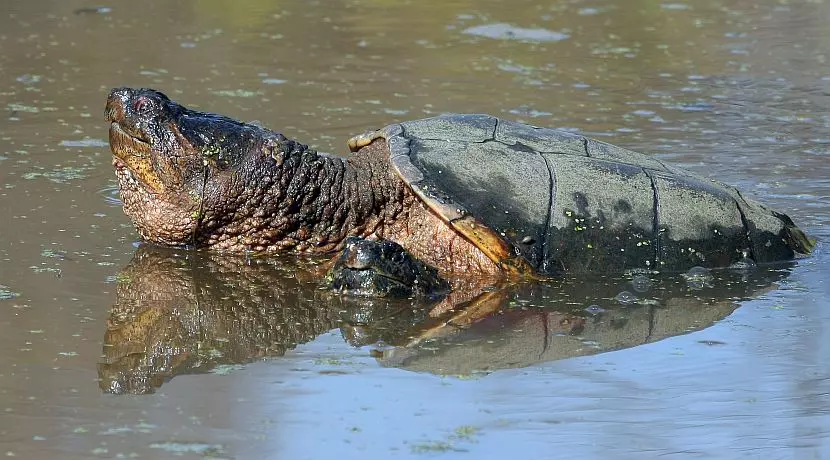If you came across one of these rather odd looking beasts on your travels you could be forgiven for thinking that you had found an interesting new Pokémon on the app on your phone. However, the snapping turtle is no fictional creature. These fearsome predators are found all over the continent of North America, and their almost prehistoric looks are reminiscent of a time gone by.
So how did they get their name?
These turtles are unlike the ones you are used to seeing serenely floating through the world’s oceans. They are famed for their aggressive and combative disposition when out of water, and with their formidable beak-like jaws, they are more than a match for animals much bigger than themselves. Unlike their sea bearing cousins, snapping turtles have a highly mobile head and neck, and this serpent like extremity is what gave them their scientific name Chelydra Serpentina!

To put it bluntly, you do not want to get bitten by a snapping turtle. Their jaws can clamp down at a mighty 656.81 newton’s of force, and this is more than enough to do some serious damage. If the force of the blow does not do enough damage to whatever is unfortunate to be between the jaws, their sharp beaks are perfectly designed to shred. Should you come across a snapping turtle in the wild, it is highly recommended that you leave it be, as when taken out of the water they become very aggressive, and they have the power to bite clean through a humans finger….
How long do they live for and where do they live?

Snapping turtles can rule their watery habitats for a long time, and some have been known to live up to 150 years in the wild. An average lifespan of around 25-30 years is more common though.
As for the location of the snapping turtles, they can only be found in North America. There are two different species of snapping turtle, the Common and the Alligator. The Alligator snapping turtle is the largest freshwater turtle in North America, and it is usually found in more southern areas of the United States. The Common snapping turtle is smaller and it inhabits streams and lakes from the southern part of North America right up to Canada!
What do they eat?
To cut a long story short, snapping turtles will eat essentially anything they can get their jaws around. Between tucking into their regular fare of fish and aquatic plant life, snapping turtles have been known to eat:
- Frogs
- Snakes
- Crayfish
- Large mammals including racoon or armadillos

Once they reach maturity, snapping turtles have no natural predators so they are top of the pile when it comes to selecting which food they want to eat. Sometimes, this can even include other turtles…
Quick Facts
- The common snapping turtle is New York’s official state reptile!
- Alligator snapping turtles can end up weighing up to 250 pounds
- Both species will avoid human contact at all costs, and will only snap as a last resort
- Alligator snapping turtles use a worm like appendage in their mouths as live bait to attract fish
- Never lift a snapping turtle by the tail. Even if you are helping one cross a road, lifting these animals by their tail can permanently dislocate their vertebrae. Phone your local wildlife centre and ask an expert
Snapping turtles are as fascinating as they are frightening. These unique animals have become the top dogs in their food chains thanks to an adaptation which has served them so well. We will leave you with one piece of advice, and that is to make sure you count your fingers both before and after you come across a snapping turtle….













